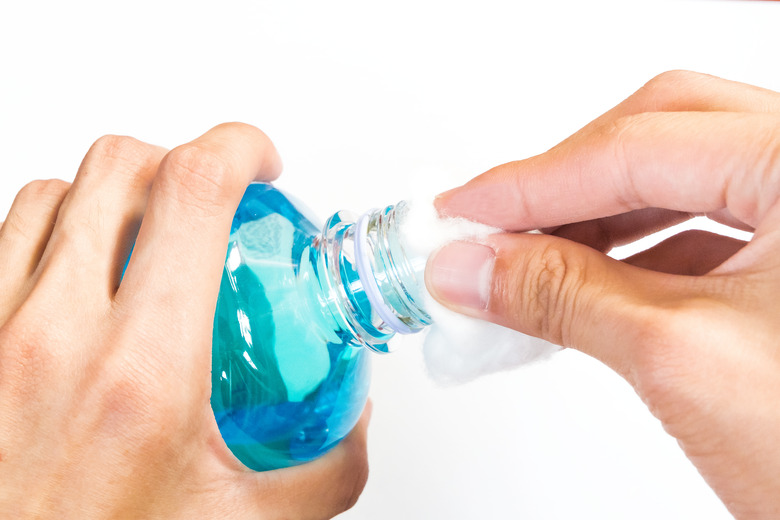Isopropanol Alcohol Vs. Isopropyl Alcohol
Isopropyl alcohol – also known as isopropanol – is commonly known as rubbing alcohol. Typically, isopropyl alcohol sold for consumer use is blended with water and is sold as an antiseptic or cleaning solution. When blended with water, isopropyl alcohol is often sold at 70% (seven parts isopropol alcohol mixed with three parts water) or 91% (91 parts isopropyl alcohol with 9 parts water) concentration. The chemical formula for isopropyl alcohol is C3H8O.
TL;DR (Too Long; Didn't Read)
Isopropanol, which is another name for isopropyl alcohol, can be used as an antiseptic, a solvent or a cleaning agent. It is important to exercise caution when using isopropyl alcohol, since it is flammable and can cause adverse effects on your health if used improperly or ingested.
Naming Convention
Naming Convention
Isopropanol and isopropyl alcohol are different names for the same chemical compound. The confusion comes from mixing two standards for naming chemicals. The suffix "ol" is part of the International Union of Pure and Applied Chemistry (IUPAC) naming system, whereas the prefix "iso" comes from the common naming system, rather than the IUPUC convention of naming chemical compunds. The correct name under the IUPAC system is Propan-2-ol; however, isopropyl alcohol is the most commonly-used name for this chemical.
Physical & Chemical Properties
Physical & Chemical Properties
Isopropyl alcohol is a clear flammable liquid at room temperature, and is capable of being mixed with water. Isopropyl alcohol has an odor which is similar to that of ethyl alcohol (commonly known as drinking alcohol). The melting point of isopropyl alcohol is -88 **°**C (-124 **°**F) and its boiling point is 108 **°**C (219 **°**F).
Applications and Usage
Applications and Usage
In addition to being used as a cleaning solution or antiseptic, isopropyl alcohol is commonly used as a solvent. Alcohols such as isopropanol mix together well with other chemicals that have similar chemical structures, such as some types of ink and paint. This property of isopropyl alcohol allows it to be used to dissolve many organic compounds that other solvents, such as water, cannot dissolve. Isopropyl alcohol may also be used for dissolving some types of plastics, such as acrylic and epoxy resins.
Safety & Toxicology
Safety & Toxicology
It is important to use caution when working with isopropyl alcohol, since it is flammable and can have some negative health effects. For example, inhaling isopropyl alcohol vapors may irritate your respiratory tract, and high concentrations of isopropyl alcohol vapor can cause dizziness, drowsiness, headache, staggering and unconsciousness. Ingestion of isopropyl alcohol can cause gastrointestinal issues such as cramps, vomiting and nausea. Isopropyl alcohol can also irritate your skin and eyes, as well as cause eye damage. To avoid accidental overexposure to isopropyl alcohol, you may wish to take precautions such as wearing protective equipment – such as lab goggles and protective gloves – as well as working with isopropyl alcohol in a well-ventilated area.
References
- Fischer Scientific; Material Safety Data Sheet; "Isopropyl alcohol 70% in water"
- The National Academies of Sciences, Engineering and Medicine; "Emergency and Continuous Exposure Limits for Selected Airborne Contaminants: Volume 2"
- University of California at Los Angeles; "Illustrated Glossary of Organic Chemistry"
Cite This Article
MLA
Anderson, Samantha. "Isopropanol Alcohol Vs. Isopropyl Alcohol" sciencing.com, https://www.sciencing.com/isopropanol-alcohol-vs-isopropyl-alcohol-8713406/. 26 April 2018.
APA
Anderson, Samantha. (2018, April 26). Isopropanol Alcohol Vs. Isopropyl Alcohol. sciencing.com. Retrieved from https://www.sciencing.com/isopropanol-alcohol-vs-isopropyl-alcohol-8713406/
Chicago
Anderson, Samantha. Isopropanol Alcohol Vs. Isopropyl Alcohol last modified March 24, 2022. https://www.sciencing.com/isopropanol-alcohol-vs-isopropyl-alcohol-8713406/
